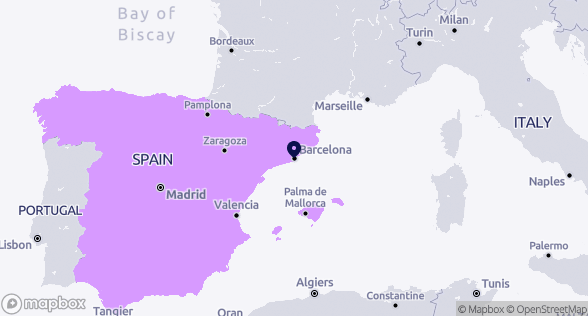
Barcelona
Spain

This is a case study as part of an UIA report. You can access all of the project's resources on its project collection page.
1. Short project description
Barcelona being a compact city of 1.6 million inhabitants with a hot and humid climate in the warm period of the year, is exposed to excessive heat burden which is expected to increase in the following years due to the increased frequency and intensity of heatwaves as a result of climate change.
Mitigating heat is important for the wellbeing of the residents, for improving social cohesion within the city as well as safeguarding the local economy and jobs taken that they depend on tourism, which in turn may be adversely impacted by climate change.
The GBG_AS2C project proposes an innovative adaptation plan to climate change through the conversion of schoolyards to climate shelters with a mix of blue (incorporation of water points of different types in the courtyards), green (more shadow spaces and greenery in the courtyards), and gray (interventions on the buildings and use of permeable materials) measures.
The project is implemented in the context of Barcelona’s Climate Plan, which promotes the transformation of communal spaces as a climate change tackling strategy. In its general perspective, it is considered an emerging green sector, taken that it has developed a new market on climate-based urban design and planning as well as green constructions at the neighborhood scale. Furthermore, it promotes the use of Climate-friendly materials and energy efficiency techniques at the building scale, in view of reducing emissions of carbon dioxide.
The project has a strong pillar on urban health, by means of reducing the concentrations of air pollutants and improving thermal comfort both indoor and outdoor. To this end, the pathway of Barcelona towards climate neutrality is enhanced, whereas the dispersion of the Climate Shelters to all districts of the city, and most importantly to deprived ones, supports just transition.
The project is linked to the climate change adaptation plan of the City of Barcelona and is based on a participatory process for selecting the measures to be applied per Climate Shelter, with close attention given to the spatial environmental, climatic, urban, and social characteristics of Barcelona
The output of the project so far, is a network of 30 Climate Shelters dispersed all over the city, a fact that is a strong asset for adapting to climate change in terms of excess heat. Furthermore, the project has resulted in a new municipal approach for urban space interventions and green constructions as well as to new governance practices.
2. GBG_AS2C and Just Transitions
Barcelona has developed an ambitious Climate Plan aiming at the improvement of the resilience of the city to climate change as well as the transformation of the city to Climate Neutral by the year 2030. The plan is based on science, is focused on people, supports a cross-cutting response to climate change impacts, is innovative in terms of the methods and tools used, has measurable targets, and reflects a solid participatory approach as interventions are designed with and for the society. The plan increases the resilience of Barcelona to climate change and thus preserves the city’s social and economic life, especially considering that the latter strongly depends on tourism, which is considered vulnerable to climate change.
The UIA project, in particular, contributes to the preparation of Barcelona to face, increasingly high temperatures in summer that would severely affect the city operations, the local economy as well as its inhabitants, especially the vulnerable ones.
Urban policies on climate change can improve residents’ lives in the form of cleaner air, better-insulated buildings, energy savings, more green areas, and better thermal comfort conditions. Furthermore, such policies have strong socio-economic dimensions in the sense that they protect the most vulnerable part of the population, safeguard social cohesion and mitigate the impacts of climate change on tourism.
To this end, the conversion of open spaces (schoolyards in the case of the UIA project) in all city districts to Climate Shelters supports the overall plan of the city to adapt to climate change. Furthermore, it promotes Climate-friendly urban planning as an emerging green sector, practically a mix of climate-sensitive architecture, green and energy-saving constructions, new materials for the urban fabric, energy efficiency technologies, interventions to the urban form and functions, nature-based solutions, and air quality sensors, the latter for monitoring and evaluation. The project also supports although to a limited extent so far, the transformation of Barcelona to climate neutral, taken that it gradually increases greenery in the city and thus expands the sinks of CO2.
The city has introduced innovation in its Climate Plan, a fact which is supportive for emerging green sectors in the overall field of Climate-friendly urban planning and in particular in such sectors as green constructions, building materials, energy retrofitting and smart systems, nature-based solutions, environmental technologies for measurement and evaluation, etc.
A barrier for cities is usually the inertia of the public sector for green procurements or the lack of skilled personnel for green techniques and technologies. In the case of Barcelona, the UIA project has shown the merit of blue, green, and grey infrastructure for climate change adaptation, whereas the green dimension has been integrated into public procurements. In terms of the personnel needed, skilling and reskilling initiatives are needed to cope with new developments in the green sectors, especially in the field of energy systems and new – Climate-friendly– construction materials.
A potential barrier maybe also the reluctance of the private sector to promote investments along the line of the UIA project, as the investment may not be in their core business or they do not recognize the return on the investment. In this case, incentives may be provided by the local and regional authorities.
A shift of the construction and tourism industries to planning systems, interventions, techniques, and technologies with the potential to “green” the city and increase its climate resilience is necessary. The demonstration of the results of the UIA project may be catalytic to this direction, along with a new perspective on spatial planning and building regulations as defined by the city authority and/or the Regional Government.
3. How does the UIA intervention promote Just Transitions?
Although not its main objective, the project GBG_AS2C supports emerging green sectors in several ways. At first, it presents what type of businesses are needed to support adaptation to climate change at the urban scale: architectural firms specializing in bioclimatic and green design principles, construction companies for energy-efficient buildings, companies producing green construction materials, energy consultants, and firms for smart energy systems, firms specializing in nature-based solutions.
Second, it defines the jobs needed, for instance, architects specialized in bioclimatic and climate-friendly buildings, engineers and scientists with knowledge for energy-efficient buildings, passive cooling and the use of cool materials for buildings/pavements/roads, energy experts in the field of smart energy systems for energy efficiency and energy retrofitting of buildings, experts in nature-based solutions, financial experts with specialization to renewable energies and climate neutrality, etc.
Taken the above, it would be important if the city authorities devised skilling and reskilling initiatives to support the new requirements for the labor force, as far as the emerging green sector of Climate-friendly urban design is concerned.
Taken its size, the UIA project does not result by itself in Just Transition; it rather supports the program developed by Barcelona to turn to Climate Resilient and Climate Neutral city.
4. Keys to success
Analysis of the Barcelona case identifies several factors that have helped the successful implementation of the project. These factors are:
a. Strong political support for the project and its continuation.
The City of Barcelona has integrated the project into the overall Climate Plan of the city and has decided to grant the upscaling of the project by an amount of roughly 2.5 million euros per year.
b. Proactive climate policy
The project has taken advantage of the early preparedness of the City of Barcelona concerning climate change, namely an ambitious and well-structured Climate Plan with a strong climate change adaptation pillar.
c. Multi-disciplinary cooperation model
The project is implemented through a cooperation model between the Barcelona City Council and several other city agencies and Institutes from the health, education, construction, and environment sectors. In this way, strong complementarities are achieved and a holistic approach has been worked out to address the urban climate problem.
d. Innovation in action
The project introduced an innovative approach, namely the conversion of schools (and schoolyards) to Climate Shelters, through green, blue and grey infrastructure. In this way, it gained attention from the education and local societies and acted as the testbed for innovative urban solutions.
e. Strong social dimension
The main objective of the project is to protect residents from the adverse impacts of heatwaves, with particular attention given to vulnerable populations. The pilot sites of the project are located in all districts of the city, whereas the selection criteria take note of the state of the thermal environment and air quality per district.
f. Participatory process at the neighborhood scale
A thorough co-creation participatory process was implemented and was closely followed at all stages of the project. The process of the UIA project is an excellent showcase of urban governance with and for the citizens, namely decision making as close as possible to the citizen, open deliberations, and finally co-creation of interventions and technical solutions.
5. Upscaling and replication potential
In the course of the implementation of the UIA project, the decision by the City of Barcelona is to upscale the project by converting 10 more schools per year to Climate Shelters, with the use of the successfully tested blue, green, and grey infrastructure.
The replication of the project shows momentum for the emerging green sector of Climate-friendly urban planning and its components, namely green constructions, energy-efficient buildings and smart energy systems, cool materials, nature-based solutions, and sensors for monitoring and evaluation.
It is important to note that the municipalities of Barcelona and Paris have worked out a cooperation framework based on their UIA projects for climate adaptation at the urban scale. Through cooperation, knowledge transfer and experience sharing takes place. This type of cooperation may roll out as a model for the replication of Climate-friendly urban planning in more European cities. The European Commission policy for the adaptation of cities to climate change and their transformation to Climate Neutral ones as early as 2030, sets a promising framework for the said emerging green sector.
About this resource
The Urban Innovative Actions (UIA) is a European Union initiative that provided funding to urban areas across Europe to test new and unproven solutions to urban challenges. The initiative had a total ERDF budget of €372 million for 2014-2020.
Similar content






Want to replicate this urban practice in your city?
Apply to an EUI City-to-City Exchange
Connect with a peer city who can bring you solutions and expertise and apply together to receive EUI support
More infos on EUI websiteBrowse existing Innovative Actions looking for Transfer Partners and cities willing to do a City-to-City Exchange looking for peers